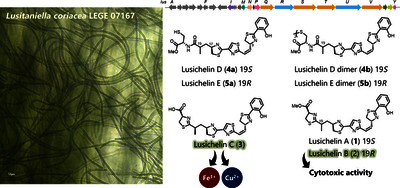Sousa, Maria Ligia and Ferreira, Leonor and Ferreira, Dora and Forero, Abel M. and Castelo-Branco, Raquel and Szemerédi, Nikoletta and Spengler, Gabriella and Rodriguez, Jaime and Jimenez, Carlos and Leao, Pedro N. and Vasconcelos, Vitor and Reis, Mariana Alves (2025) Decoding Lusichelins A-E: An In-Depth Look at the Metallophores of Lusitaniella coriacea LEGE 07167-Structure, Production, and Functionality. JOURNAL OF NATURAL PRODUCTS. ISSN 0163-3864
|
Text
sousa-et-al-2025-decoding-lusichelins-a-e-an-in-depth-look-at-the-metallophores-of-lusitaniella-coriacea-lege-07167-1.pdf - Published Version Available under License Creative Commons Attribution. Download (3MB) | Preview |
|
![[img]](https://real.mtak.hu/219908/7.hassmallThumbnailVersion/images_large_np5c00204_0008.jpeg)
|
Text (graphical abstract)
images_large_np5c00204_0008.jpeg - Published Version Available under License Creative Commons Attribution. Download (164kB) | Preview |
Abstract
Essential trace metals are vital for cellular processes, such as respiration, DNA replication, and photosynthesis. Cyanobacteria must tightly regulate metal homeostasis to prevent deficiency or toxicity, yet their metallophores remain overlooked. Here, we report lusichelins A-E (1-5), new metallophores isolated from the marine cyanobacterium Lusitaniella coriacea LEGE 07167. Their structures and configurational assignments were determined by using NMR, mass spectrometry, TD-DFT calculations, and retrobiosynthetic insights. Lusichelins feature a unique structural arrangement with thiazoline/thiazole rings connected via a vinyl group, an aliphatic carbon chain, or directly enabling the potential for metal coordination. Genomic analysis identified a hybrid PKS/NRPS biosynthetic gene cluster consistent with the lusichelin structure, bearing traits characteristic of metallophore biosynthesis. Functionally, lusichelins act as metallophores capable of chelating both iron and copper. Lusichelin C (3) consistently bound iron under both metal-rich and metal-limited culture conditions, while copper complexation was only observed under elevated copper levels. At physiologically relevant pH values, no significant metal-binding preference was detected. Moreover, compound production was maximized under metal-rich conditions and in response to copper limitation. Lusichelin B (2) exhibited cytotoxicity against colon carcinoma cells while reversing multidrug resistance via ABCB1 efflux pump modulation. These findings expand our understanding of cyanobacterial metallophores in microbial metal homeostasis and highlight their biological potential.
| Item Type: | Article |
|---|---|
| Uncontrolled Keywords: | CONFIGURATION; biosynthesis; CYANOBACTERIA; SIDEROPHORE; Chemistry, Medicinal; Plant Sciences; POLYCHLORINATED LEUCINE DERIVATIVES; |
| Subjects: | Q Science / természettudomány > QD Chemistry / kémia R Medicine / orvostudomány > RM Therapeutics. Pharmacology / terápia, gyógyszertan |
| SWORD Depositor: | MTMT SWORD |
| Depositing User: | MTMT SWORD |
| Date Deposited: | 11 Jun 2025 09:33 |
| Last Modified: | 11 Jun 2025 09:33 |
| URI: | https://real.mtak.hu/id/eprint/219908 |
Actions (login required)
 |
Edit Item |




